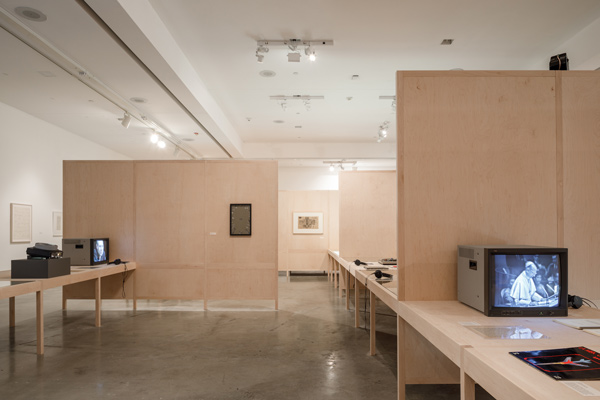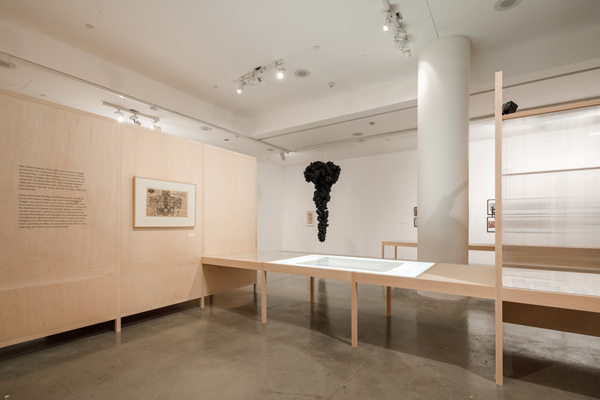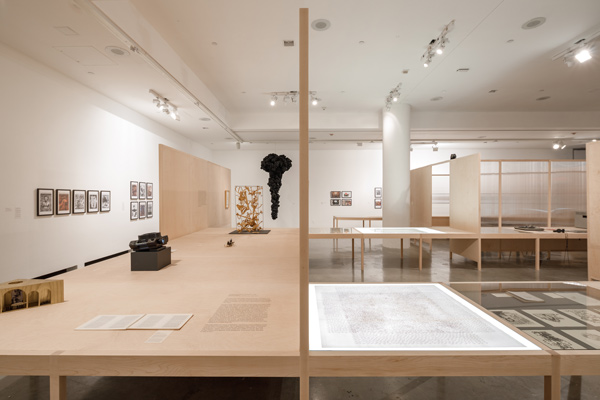In a letter to a fellow Argentine artist living in Paris, León Ferrari wrote, “We produce culture for our ideological enemies, and they gobble everything up, the pretty paintings and the protest paintings alike.” That is the continuing crisis for art that is built upon political and social protest—art is a commodity, elevated, but a commodity nevertheless, and those best positioned to consume that product are the chief beneficiaries of societal imbalance. Still, such art remains undervalued; an acidic David Hammons may sell for eight million but Paul Newman’s watch went up to eighteen—a sardonic lesson in commodification.

The Words of Others: León Ferrari and Rhetoric in Times of War, 2017. Exhibition view at REDCAT. Photo: Taiyo Watanabe.
Lesson retention, one learns from educators, is aided by the receipt of the same information in a variety of media. The lecture alone is the least effective; reading only somewhat more. Thus, the sandwich-boarded street-corner Jeremiah faces a weighty task in converting the passerby; his hand-painted placard striving to convey more particulars and statistics than the sign can legibly hold. His eyes wild, bark urgent, fist shaking, he remains entertainment.

The Words of Others: León Ferrari and Rhetoric in Times of War, 2017. Exhibition view at REDCAT. Photo: Taiyo Watanabe.
Through drawings, sculpture, collage, drama, and text, Ferrari (1920-2013) alternately bellows and whispers and shakes his fist at Pope Paul VI, President Johnson, and Adolph Hitler. While a recording of his quotation drama Palabras ajenas (The Words of Others) (1967) fills the gallery, the artist gives us a slide show of Nazi memorabilia—the real slide projector neatly conveying us back to the 1970s. In other works, both witty and tragic, he demands accountability from political and religious leaders. His clever collages Relecturas de la Biblia (1986-87) skewer the Catholic Church through a series of Japanese erotic prints inhabited by a spectral God, saints, and angels; his figure-icon prints Espectadores Reprocos (1981) and Cruzamento(1982) give overhead views of contrary audiences and conflicting marchers; his Hongo Negro Nuclear (2007) sculpture of a mushroom cloud and Huesos (2006), a glassless vitrine of turbulent bones, foreshadow the conclusion of his morality play.

The Words of Others: León Ferrari and Rhetoric in Times of War, 2017. Exhibition view at REDCAT. Photo: Taiyo Watanabe.
One video monitor loops Adrian Mitchell reading his plaint of a poem Tell Me Lies About Viet Nam. When the poem ends, the applause rises, the camera pans the enthusiastic crowd then settles upon a single admirer, Allen Ginsberg.
Even the revolution requires its celebrity cameos.

The Words of Others: León Ferrari and Rhetoric in Times of War, 2017. Exhibition view at REDCAT. Photo: Taiyo Watanabe.
“The Words of Others: León Ferrari and Rhetoric in Times of War,” September 16 – December 17, 2017 at REDCAT, 631 West 2nd Street, Los Angeles, CA 90012, www.redcat.org.



















0 Comments